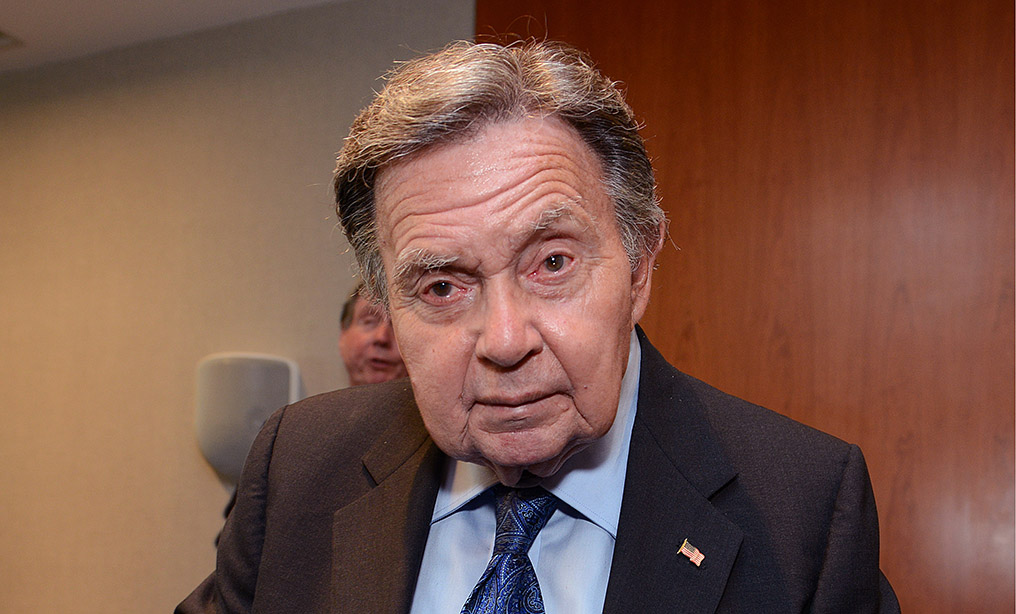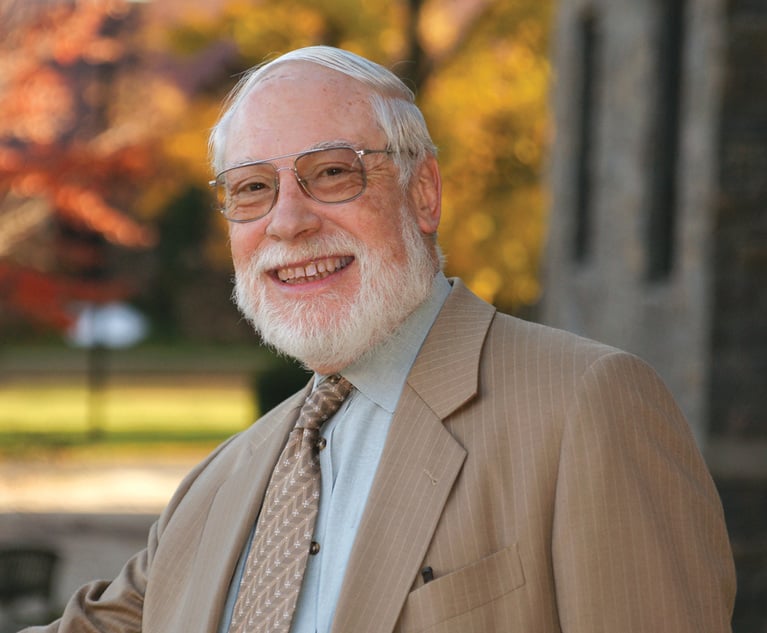King of the Bugs: A Tribute
His legacy in all he accomplished is a compelling one. And in the area of electronic surveillance it is a standard that will be difficult to ever match.
December 27, 2019 at 01:00 PM
7 minute read
 Queens District Attorney Richard A. Brown (Photo: Rick Kopstein/NYLJ)
Queens District Attorney Richard A. Brown (Photo: Rick Kopstein/NYLJ)
He was once referred to by a news reporter as the "King of the Bugs." The title of the article had nothing to do with his physical stature, though despite standing at about five feet, District Attorney Richard A. Brown, otherwise known as "the Judge," was always the tallest man in the room. Instead, the reference was to his preeminence in the world of electronic surveillance. When he was appointed the District Attorney of Queens County by the Governor in 1991, he articulated his primary mission—to elevate the level of professionalism in the office—and he took particular interest in the office's then-dormant capability in electronic surveillance under Article 700 of the New York State Criminal Procedure Law (CPL).
Initially, he focused on the investigations division. As part of his mission he created an investigative capability including an electronic surveillance capability that was by far the best in the state and according to the Administrative Office of the United States Courts (AO), which provides an annual report to Congress concerning intercepted wire, oral, or electronic communications as required by Title III of the Omnibus Crime Control and Safe Streets Act of 1968, codified at 18 U.S.C. §2519, was consistently among the top three state prosecutors' offices in the country.
Section 2519 (3) of Chapter 18 of the United States Code requires the AO to report the number of federal and state "applications for orders authorizing or approving the interception of wire, oral, or electronic communications pursuant to this chapter and the number of orders and extensions granted or denied pursuant to this chapter during the preceding calendar year," along with a summary and analysis of data required by §2519 to be filed with the AO. See United States Courts, Wiretap Reports. These annual reports provide compelling evidence of DA Brown's legacy.
DA Brown knew from his prior experience reviewing countless wiretap applications as a Justice of the Appellate Division, Second Department, the significant value of the use of electronic surveillance otherwise known as "wiretaps" in the prosecutor's toolbox.
For instance, by the time of the height of the drug cartel and gang kidnapping sprees of the 1990s and 2000s, Judge Brown had assembled and trained a team of attorneys and investigators that could draft a wiretap warrant from scratch in short order, leading to the rescue of many victims and the arrest of countless heinous offenders. His dedication to detail and professionalism eventually was a key ingredient to the elimination of drug related kidnappings not only in Queens County but Citywide. Moreover, the use of this investigative technique was key to eviscerating organized crime's foothold in Queens. The Gambino Crime Family's stranglehold on the stolen car industry was released. Car thefts plummeted from 50,000 a year to less than 2,000. The drug cartels took a significant hit in both narco products and drug proceeds seized. Gun trafficking was interdicted with significant gun seizures commonplace. Gang activity was reduced and crime trends plummeted. Organized criminals correctly assessed that operating in Queen County was too risky. There was less potential profit in the crime and the risk of capture was too great to chance.
But in accomplishing one of his most successful endeavors, the substantive work went on mostly unnoticed because most cases ended quietly in guilty pleas given the enormity of the evidence obtained from the electronic surveillance. In this arena, that of electronic surveillance, most of DA Brown's greatest work lies below the surface and few others than those who worked closely with him will ever know the full picture of the man. The stories will never appear in the dustbins of history. This one will. He always supported my Law Journal writing. He reminded me before he died, "to tell them about my wiretaps."
Electronic surveillance can be a pernicious tool, but in the hands of skilled, professional and ethical law enforcement officers it can result in evidence that no other source can provide. Statements are obtained straight out of the target's mouth uncluttered by informant filters, or police interrogation tactics or other practical unplanned-for obstacles. No doubt, the wiretap laws provide numerous admissibility hurdles, but a knowledgeable and astute prosecutor assisted by an able investigative team will endeavor to satisfy every legal requirement.
The authorization order, known as an eavesdropping warrant, only lasts for 30 days and must be extended, if appropriate, before it expires. The records of the conversations or electronic communications must be preserved and sealed before the expiration and a judge's sealing order and signature is required to preserve the intercepted evidence. Notices to the defense during the course of any litigation must be scrupulously honored. The communications must be audible and that's only a partial list of the requirements involved under Article 700 of the CPL.
And yet with all these potential pitfalls, DA Brown encouraged his staff to seek such orders when needed and the legal predicates were satisfied. Wiretap applications, which under his predecessors were almost non-existent, steadily increased as prosecutors and police gained knowledge and confidence in the use of this worthwhile tool to protect the public. The cost to Judge Brown was enormous in impact on his own time. He had to be available to review and authorize the applications for the wiretaps whenever called upon, that is, 24 hours a day, seven days a week.
In almost 28 years as the highest law enforcement officer in the County of Queens, he never faltered. He loved to review the documents and underlying investigations with his prosecutors and police officers. Law enforcement offices from various state, local and federal offices frequently visited his office to obtain his endorsement on the applications, the first step before approval by a disinterested judge of the New York State Supreme Court or the Appellate Division. In these meetings, not only did he review the probable cause—the standard of proof required in such applications—but he also encouraged the prosecutors and investigators to discuss the cases, themselves, their families and careers.
In these countless intimate gatherings, he shared his life experiences and encouraged his staff and others to set their sights high, to do the best they could and to live up to the highest ethical standards. And he was a wonderful role model. He lived as he spoke with dignity and quiet confidence and assurance. He did not take himself too seriously, and always asked how his people were doing—not only how the case was progressing but how the prosecutors and investigators were, what they saw on the street and what had they thought needed to be corrected. He gave direction as well as listened intently to the information provided. There was a give and take and you always knew you would get a fair and honest review of your work.
His legacy in all he accomplished is a compelling one. And in the area of electronic surveillance it is a standard that will be difficult to ever match.
Peter A. Crusco is the executive assistant district attorney, Investigations Division, Office of the Queens County District Attorney. The views expressed herein are the author's, and do not necessarily reflect the policies or views of the office.
This content has been archived. It is available through our partners, LexisNexis® and Bloomberg Law.
To view this content, please continue to their sites.
Not a Lexis Subscriber?
Subscribe Now
Not a Bloomberg Law Subscriber?
Subscribe Now
NOT FOR REPRINT
© 2025 ALM Global, LLC, All Rights Reserved. Request academic re-use from www.copyright.com. All other uses, submit a request to [email protected]. For more information visit Asset & Logo Licensing.
You Might Like
View All
Law Journal Column on Marital Residence Sales in Pending Divorces Puts 'Misplaced' Reliance on Two Cases
8 minute read

A Time for Action: Attorneys Must Answer MLK's Call to Defend Bar Associations and Stand for DEI Initiatives in 2025
5 minute readTrending Stories
- 1ACC CLO Survey Waves Warning Flags for Boards
- 2States Accuse Trump of Thwarting Court's Funding Restoration Order
- 3Microsoft Becomes Latest Tech Company to Face Claims of Stealing Marketing Commissions From Influencers
- 4Coral Gables Attorney Busted for Stalking Lawyer
- 5Trump's DOJ Delays Releasing Jan. 6 FBI Agents List Under Consent Order
Who Got The Work
J. Brugh Lower of Gibbons has entered an appearance for industrial equipment supplier Devco Corporation in a pending trademark infringement lawsuit. The suit, accusing the defendant of selling knock-off Graco products, was filed Dec. 18 in New Jersey District Court by Rivkin Radler on behalf of Graco Inc. and Graco Minnesota. The case, assigned to U.S. District Judge Zahid N. Quraishi, is 3:24-cv-11294, Graco Inc. et al v. Devco Corporation.
Who Got The Work
Rebecca Maller-Stein and Kent A. Yalowitz of Arnold & Porter Kaye Scholer have entered their appearances for Hanaco Venture Capital and its executives, Lior Prosor and David Frankel, in a pending securities lawsuit. The action, filed on Dec. 24 in New York Southern District Court by Zell, Aron & Co. on behalf of Goldeneye Advisors, accuses the defendants of negligently and fraudulently managing the plaintiff's $1 million investment. The case, assigned to U.S. District Judge Vernon S. Broderick, is 1:24-cv-09918, Goldeneye Advisors, LLC v. Hanaco Venture Capital, Ltd. et al.
Who Got The Work
Attorneys from A&O Shearman has stepped in as defense counsel for Toronto-Dominion Bank and other defendants in a pending securities class action. The suit, filed Dec. 11 in New York Southern District Court by Bleichmar Fonti & Auld, accuses the defendants of concealing the bank's 'pervasive' deficiencies in regards to its compliance with the Bank Secrecy Act and the quality of its anti-money laundering controls. The case, assigned to U.S. District Judge Arun Subramanian, is 1:24-cv-09445, Gonzalez v. The Toronto-Dominion Bank et al.
Who Got The Work
Crown Castle International, a Pennsylvania company providing shared communications infrastructure, has turned to Luke D. Wolf of Gordon Rees Scully Mansukhani to fend off a pending breach-of-contract lawsuit. The court action, filed Nov. 25 in Michigan Eastern District Court by Hooper Hathaway PC on behalf of The Town Residences LLC, accuses Crown Castle of failing to transfer approximately $30,000 in utility payments from T-Mobile in breach of a roof-top lease and assignment agreement. The case, assigned to U.S. District Judge Susan K. Declercq, is 2:24-cv-13131, The Town Residences LLC v. T-Mobile US, Inc. et al.
Who Got The Work
Wilfred P. Coronato and Daniel M. Schwartz of McCarter & English have stepped in as defense counsel to Electrolux Home Products Inc. in a pending product liability lawsuit. The court action, filed Nov. 26 in New York Eastern District Court by Poulos Lopiccolo PC and Nagel Rice LLP on behalf of David Stern, alleges that the defendant's refrigerators’ drawers and shelving repeatedly break and fall apart within months after purchase. The case, assigned to U.S. District Judge Joan M. Azrack, is 2:24-cv-08204, Stern v. Electrolux Home Products, Inc.
Featured Firms
Law Offices of Gary Martin Hays & Associates, P.C.
(470) 294-1674
Law Offices of Mark E. Salomone
(857) 444-6468
Smith & Hassler
(713) 739-1250







